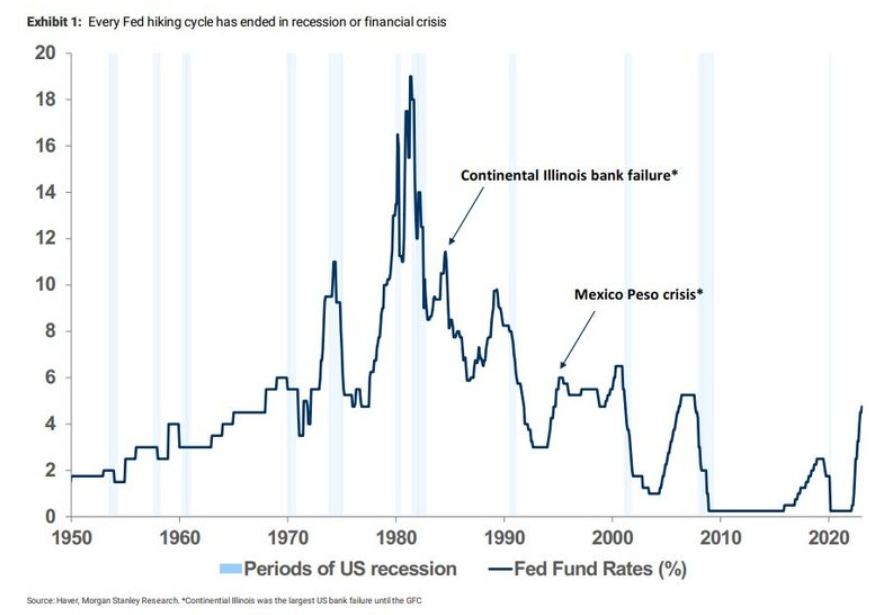Welcome to the land of Dazed and Confused.
I wrestle with these weekly Outlooks.
Having been “in the action” for over 35 years in financial consulting and then in the marketing of asset management products to individuals and thousands of RIAs, I have gotten a chance to spend time with many economic and investment gurus over the years. Today I probably receive as many as 10 such investment updates and newsletters from people much smarter than me.
When writing these Outlooks, picking a subject matter is usually easy. We choose from the most relevant and important stories of the week. The important issues usually rise to the top of the financial world consciousness. Such as last week on the SVB banking crisis or the week before with CPI and PPI. Easy pickings.
Not so this week. There are far too many disjointed economic scenarios playing out. These are all meaningful problems that could have a serious impact on the financial condition of the U.S.
I am plagued by the fact that as a publisher of financial information, we should put out POSITIVE and MOTIVATING information.
However, in the past year we have expended many words trying to share with our readers what could go wrong….where the headwinds lie, and where to seek safety and investing calm.
These are the reasons I joined a firm that offers investors (through subscriptions) or direct asset management A BETTER WAY!
We specialize in transparent, dynamic, adaptive, active, and tactical solutions. This is the method we think works better... why? Because at the center of what we do is our overall approach to risk management and risk aversion.
The economic picture we lay out today is cloudy and confusing at best. Personally, I am concerned that the “bottom” could fall out. All of us at MarketGauge have been in this business for a good amount of time. We have seen just about every kind of market and economic storyline. We try and synthesize different scenarios so that we can help to protect YOU, our readers and investors.
The Current State of Affairs
As Mish frequently talks about on her national TV appearances, as well as her writing extensively in her 2023 Outlook, “How to Grow Your Wealth in 2023”, we will experience a period of chaos. This chaos will bring about increased volatility and divergences in market indices in the Modern Family components, a lack of confidence in our institutions (think Financials) as well as chaos in governments around the world. This should lead to a flight to quality, which inevitably may drive money to gold and silver. (Gold was up big this past week with one of its biggest rallies in years on Friday - up more than $60).
She wrote this about the year, 2023, but this pretty well sums up the year so far. Remember, we are only in March. Let’s review what has taken place already in 2023 (we will cover a few in more detail in the remainder of the Outlook)
- The New York Stock Exchange (NYSE) halts 200+ stocks impacting $1 trillion in trade volume.
- The 2nd and 3rd largest bank collapses in U.S. history.
- The Fed injects over $200 trillion in a bank lending facility thus creating Quantitative Easing while at the same time draining liquidity from the system in Quantitative Tightening.
- Major banks put up $30 billion to shore up deposits at First Republic Bank (NYSE:FRC)
- The Administration basically “Nationalizes” all banks by backstopping all depositors irrespective of a cap of $250,000 from the FDIC.
- The housing market is falling at the fastest pace since 2011.
- S. NOTAM system goes down, grounding all flights.
- CPI Inflation formula changed for the first time in years.
- Mortgage rates hit 7.1%, sending mortgage demand to the lowest since 1993.
- Credit card debt hits record $985 billion.
- Chinese spy balloon shot down over the U.S.
- Geopolitical risks rise as enemy countries begin to work together and against U.S. interests.
- Nearly 300,000 people have been laid off in tech. More layoffs were announced this week. (see layoff list below)

- Analysts’ ratings on stocks are still mostly positive. Notice that 92% of analysts covering the financial sector rated these stocks as a buy or hold. See the chart below:


The list of economic and financial problems grows daily. This is why the markets continue to gyrate and money quickly comes out of one sector (financials and energy) and flows to another. (technology and semiconductors). This past week saw:
- The S&P was slightly positive.
- Growth-oriented stocks, especially technology stocks (QQQ), were up over 4%.
- The NDX was up the most since November 2022
- Bank stocks tumbled and were down 15%
- Oil dropped by 13.7%
- Small-cap stocks were down on the week over 2.5%
- Bonds rallied big
- Gold and Silver were up big. Friday, gold soared over $60
- Strength in semiconductor companies and weakness in oil companies
See the charts below:

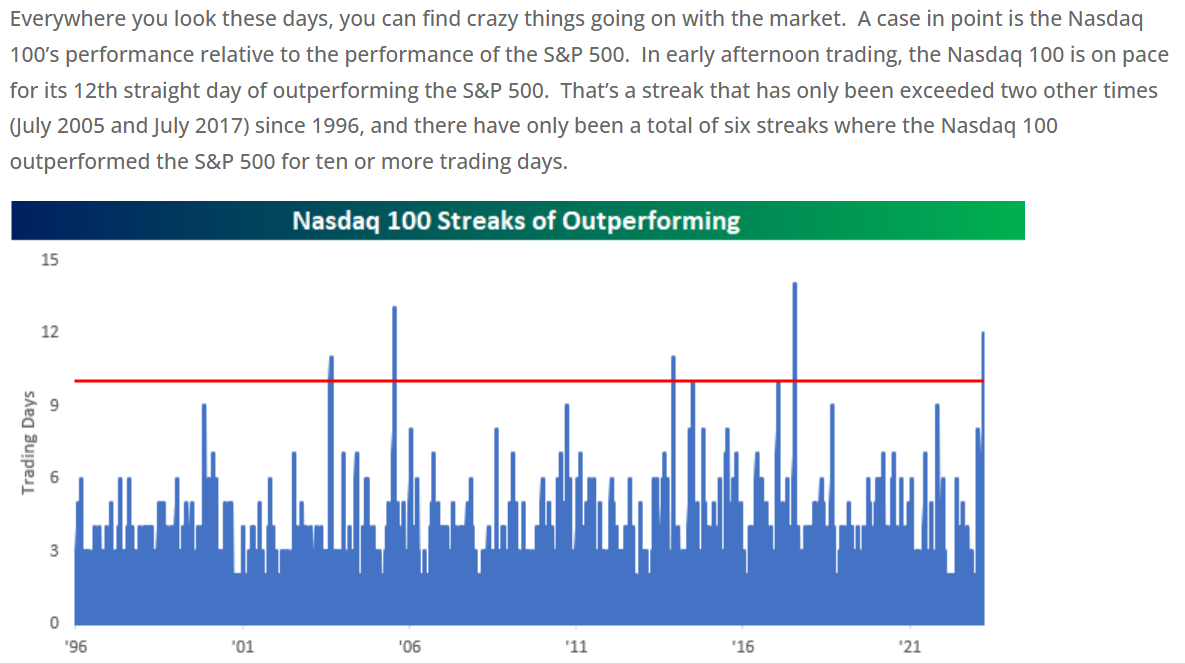
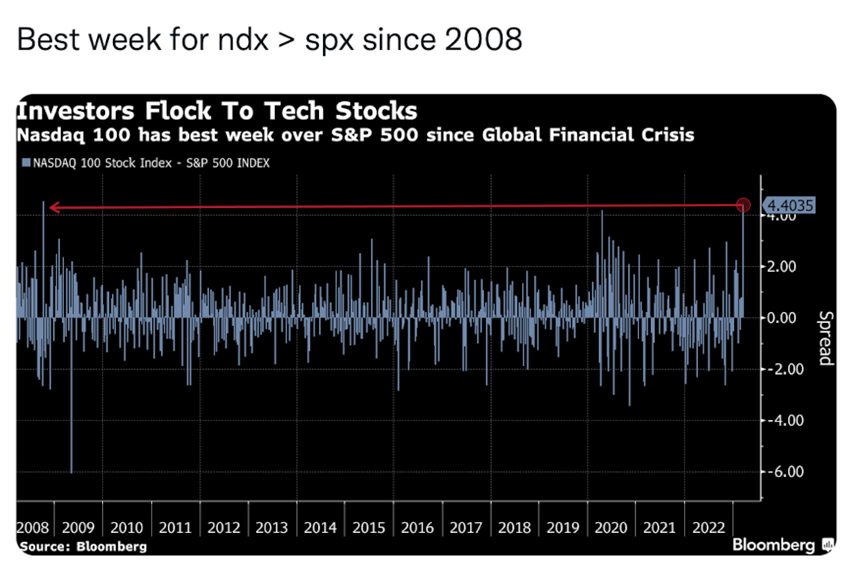
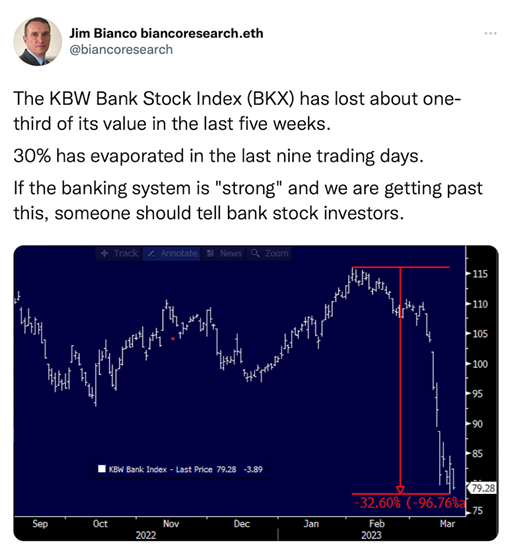
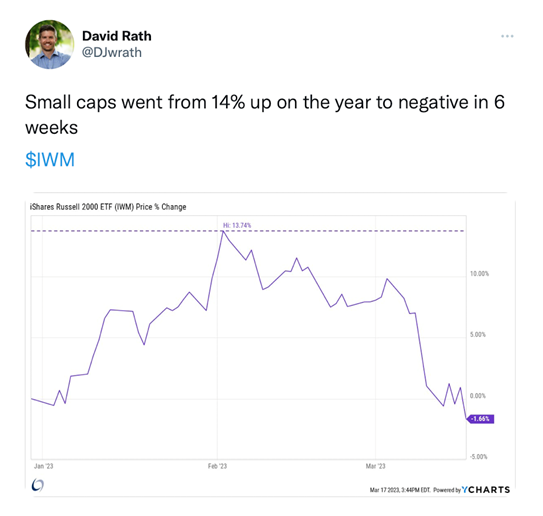

Enhanced volatility and large swings in the stock and bond markets will likely continue.
Let’s explore a couple of other cloudy and confusing pictures.
What Will the Federal Reserve Do at Their Upcoming Meeting This Week?
The Federal Reserve meets this week. They have been expected to continue raising rates. Their publicized and stated targets (dot plot) calls for rates exceeding 5% on Fed borrowing rates, which began being forecasted in early 2022. In fact, as you are aware, Fed Chairman Powell had been broadcasting that rates would have to be higher and for longer given the recent hotter-than-expected CPI and PPI readings.
Prior to the Banking crisis that emerged 10 days ago, some of the economic indicators were softening, leading many analysts and futures probabilities to reduce their expectations for a 50 bp bump back down to 25 bp.
As a result of the Banking problems that continue, rumors began that not only would the Fed PAUSE this week, but would begin to pivot to an easing stance later in the year.
We have been quite steadfast in our view that the Fed would keep raising rates and would stay the course throughout 2023.
The question now is are we in enough financial trouble that the Fed changes course? On a personal level, I do not believe that is the case IF the Fed is serious about bringing down inflation closer to their target of 2%. One thing that may occur is that they come out and announce that their target is now 3% and inflation is decelerating fast enough for them to pause. We do not see them lowering interest rates anytime soon, at least not in 2023 unless we go into a serious recession. More about that in a minute.
See the most recent chart floating out there about the Federal Reserve’s next steps:
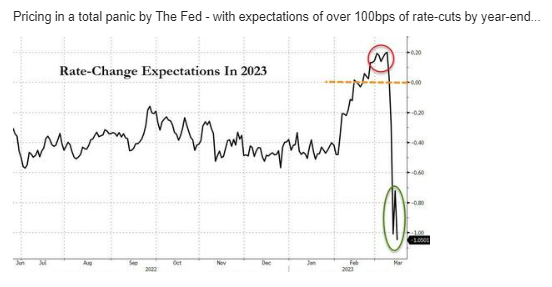
So the question remains, does the Fed fight inflation and stay on target or fight a potential liquidity crisis? As one well-known economist said this week, if these three banks were in trouble for mismanaging asset liabilities, then possibly 180 other regional and community banks are in just as much trouble.

Is a Recession in the Horizon?
I’m not too sure that what we think is that important or relevant. But with the Leading Economic Indicators (LEI) declining 0.3% in February to 110, after declining by 0.3% in January, the economy is headed that way. This marked its eleventh consecutive decline. This number does not include the recent banking crisis which could have the LEI fall by more than expected in March.
The LEI is down 3.6% over the six-month period between August 2022 and February 2023. This is a much steeper decline then the previous 0.3% decline from February 2022 to August 2022.
Overall, The Conference Board forecasts rising interest rates paired with declining consumer spending will likely push the U.S. economy into a recession sometime in the near term.
2023’s financial condition had been holding up quite well. The first two months of the year had absorbed the Federal Reserve interest-rate hikes without as much as a hiccup. After the recent banking crisis events and accompanied industry wide financial weakness become apparent in upcoming LEI numbers, that notion can be put to bed.
“Every rate hiking cycle of the last 70 years has ended in recession (c. 80% of the time) and/or a financial crisis (in 1984 and 1994),” says Graham Secker, chief European equity strategist for Morgan Stanley (NYSE:MS) in London. “A week ago it was possible to argue that this observation was theoretical, now we know that it is not going to be different this time,” he added.
Secker did note that financial crises don’t always lead to economic recessions, as evidenced in 1984, 1987, 1994 and 1998. “However, at this stage we think markets will run with the ‘guilty until proven innocent’ approach given: 1) the prospect of a material tightening in credit availability and lending standards from banks after recent events; 2) the deeply inverted yield curve going into recent events,” he said.
See the charts below indicating that avoiding a recession is nearly impossible:
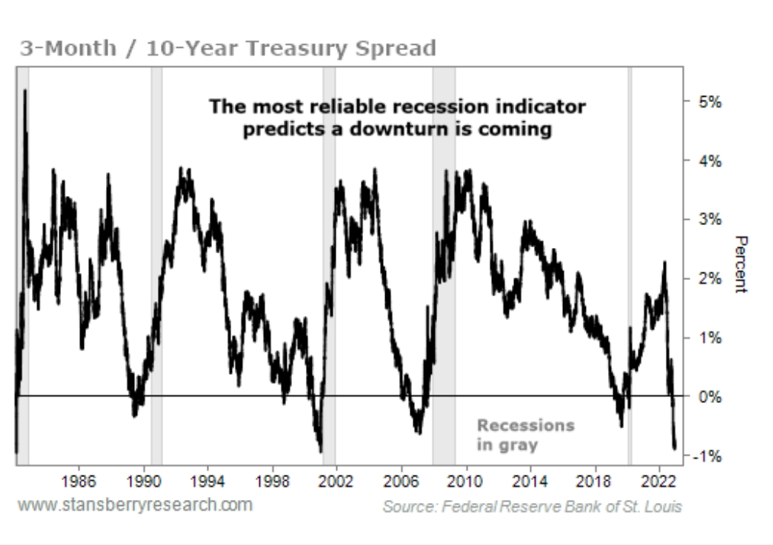
Our prediction is summed up best by the quote by Yogi Berra:

What To Do Next?
We may sound like a broken record, but what we have been saying consistently since late 2021 when we said, “It Doesn’t Smell Right,” is to stay CAUTIOUS.
We do not believe we are on firm footing yet. Our Risk Gauges are Risk-Off for the most part. As referenced above there are pockets of strength like semiconductors and other sectors of the technology-oriented NASDAQ, but we remain concerned that the investing headwinds are still quite strong.
Here are our other observations from BIG VIEW:
Risk-On
- Value stocks (VTV) have gotten crushed this past week when compared to Growth stocks (VUG) on a relative basis. VUG has reclaimed a bullish phase similar to the Nasdaq, while VTV is now underperforming relative to the rest of the US Market. (+)
Neutral
- US Indices are showing a confused picture, with QQQ reclaiming a bullish phase on both a daily and weekly timeframe. In contrast, the other 3 key indices continued to sell off and close under their 200-day moving averages and in Distribution phases. (=)
- Sector rotation shows strong outperformance this week in Tech (XLK) and Semiconductors (SMH) and a clear weakness in Energy (XLE (NYSE:XLE)). Also interesting, Utilities (XLU) was strong, which is still a risk-off indication. (=)
- Soft Commodities (DBA) appears to be matching the performance of the S&P500 and is now under pressure in a Bear phase, but remains within its long-term compression range. (=)
- Copper (COPX) looks to be testing support at its 200-day moving average but is already at oversold levels according to Real Motion, indicating a good possibility for a bounce. (=)
- Risk-Off
- Volume Patterns remain negative with zero accumulation days over the past 2 weeks in either the S&P500 or the Russel 2000. (-)
There has been a clear flight to safety plays amidst the unrest with US Banks, resulting in surges across the precious metals including Gold Minders (GDX (NYSE:GDX)), Gold (GLD (NYSE:GLD)), and Silver (SLV). (-)
The McClellan Oscillator for both the S&P500 and Nasdaq Composite bounced off deeply oversold levels but remains in negative territory, while shorter-term market internals also shows a mixed picture. (-)
The New High / New Low ratio continues to degrade for both the S&P500 and Nasdaq Composite. (-)
Risk Gauges remain in fully Bearish territory. (-)
Cash Volatility ($VIX.X) has reclaimed an accumulation phase, a Risk-off indication for equities. (-)
On a shorter-term basis, the S&P500 improved according to the number of stocks above their 10-day moving average, however, the Russel 2000 is under extreme pressure and appears to have more downside possibilities. (-)
The long bond (TLT) closed above its 200-day moving average which is the first time that this moving average has been broken since the beginning of 2022. (-)
Regardless of size or market cap, every index with a strong allocation is suffering as a result of the recent banking crisis including but not limited to IWM, MDY, and DIA. (-)
Regional Banks (KRE) turned out to be the canary in the coal mine as we watched it degrade quickly in the runup to this past week, while Semiconductors (SMH) is now the strongest component of Mish’s Modern Family. 5 of the 6 members of the Modern Family broke down hard. (-)
Gold (GLD) put in its highest close since the first quarter of 2022. (-)
US Oil (USO (NYSE:USO)) put in its lowest close since late 2021, likely due to general economic concerns. (-)

